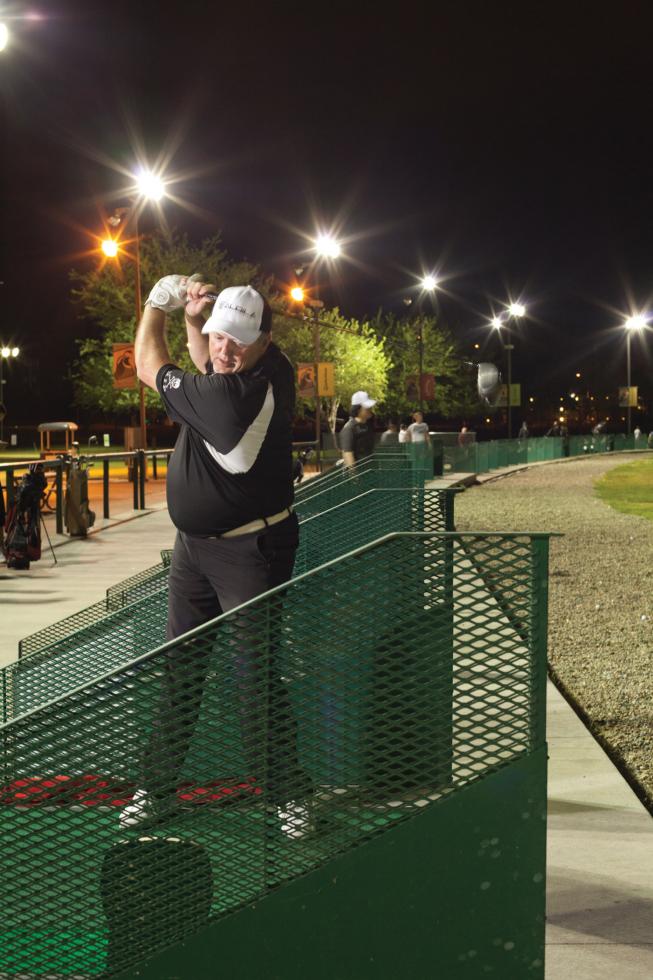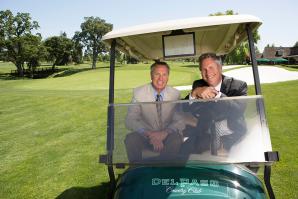Golf bag slung over his shoulder and a bounce in his step, a stocky fellow walks alone to his car in the Haggin Oaks parking lot.
“I was crushing the driver,” he says, talking more to himself than anyone else. “Absolutely crushing it.”
The same scene plays out every summer at the Haggin Oaks Golf Complex’s lighted range just off the Capital City Freeway. Open 24 hours from May through September, it’s not unusual to see cars pulling into the parking lot at 3 a.m., whether it’s people getting off the night shift at Wonder Bread, bar goers who aren’t ready to call it a night or fitful sleepers such as Tim Chatzis.
“There are those sleepless nights when I might go out there at 2 in the morning,” Chatzis says. “And believe it or not, there are people out there.”
You could say the golf industry as a whole is going through some sleepless nights. Rounds are down throughout the Sacramento region and across the nation. The recession is a major factor. Time is another issue — many golfers have too many work and family obligations to commit five or six hours to 18 holes on a regular basis.
The wet winter didn’t help the bottom line, either, making local courses virtually unplayable for weeks.
“This year we’ve got a lot of catching up to do,” says Doug Parker, the city of Sacramento’s golf manager. “Hopefully, golfers feel the same way — that they want to catch up and play more now that the weather’s nice.”
Haggin Oaks is the region’s busiest practice facility, featuring 100 hitting stalls and an automatic teeing system that allows the golfer to hit balls rapid-fire without having to bend over.
While declining to provide specific figures, Haggin Oaks head professional Mike Woods says the yearly range business at Haggin Oaks is comparable to the revenue brought in by three of the city’s 18-hole courses: Arcade Creek, Bing Maloney and Bartley Cavanaugh. Only the Alister MacKenzie Golf Course at Haggin Oaks brings in more revenue than the range.
“The range business has definitely grown,” Woods says. “Adding lights not only increases the time we’re open, but it also attracts the nongolfer. We actually have a market segment of range users who never set foot on the golf course. Golf to them is driving and short irons. I ask them about playing a round, and they don’t really see the allure.”
The Haggin Oaks range certainly benefits from its accessible location, but Morton Golf, the company that runs the city’s golf facilities at Haggin Oaks, Bing Maloney and Bartley Cavanaugh, is aggressive in cultivating new business. Haggin Oaks was named one of the top 100 ranges in the nation by Golf Range Magazine, a trade publication.
The latest innovation, the Power Tee, allows range users to dump balls into a tray. The balls disappear under the green mat and then reappear on a plastic tee. It’s possible to hit a tee shot every 10 seconds.
“The Power Tee has increased revenue,” Parker says. “People are hitting balls faster than before. We’re very pleased with that portion of it.”
Generally speaking, those who use the range during daylight hours are the more serious golfers. The night crowd is more diverse. There are boyfriends teaching their girlfriends the finer points of the golf swing. There are small groups who hit balls machine-gun style for a few minutes, then stop to chat or watch their friends hit.
And the night attracts the big bombers, such as Lonnie Scott. Scott is a 48-year-old, 6-foot-3-inch, 250-pounder who sells contracting equipment by day and hits 350-yard drives by night. He uses an extra-long driver and competes in national and international long-drive competitions.
In fact, Scott and his fellow long drivers aren’t allowed to hit drivers on the range during daylight. They’re capable of flying Pinnacles into the golfers hitting balls on the far side of the range. At night, the backside of the range is closed, giving Scott and his cohorts license to fire away.
“When you’re hitting into other people, they sort of frown on that,” Scott says. “In the daytime, I’m pretty much limited to a 3-wood since the range is 340 (yards) corner to corner.”
A bucket of 40 balls at Haggin Oaks costs $5. Forty-eight balls cost $6, all the way up to 150 balls for $14. Regulars can purchase Frequent User Bonus Cards that provide bonus balls with each bucket.
To keep the Haggin Oaks range stocked, Morton Golf buys Pinnacle balls in bulk quantities: 75,000 at a time, three times a year. On April 1, July 1 and Oct. 1, the old balls are replaced.
“They get beat up pretty fast,” Woods says. “One of the questions I hear most often is, ‘When are my new balls coming out?’ It’s vital. The quality of range balls is a big factor in golfers choosing your range.”
Bing Maloney also has a lighted range, and Mather, a county-operated course, is planning to increase its electricity bill by offering a lighted practice facility. Greg Bliek, Sacramento County’s superintendent of golf, says the range business on his courses (Mather, Ancil Hoffman and Cherry Island) brings in about $750,000 a year.
“It might sound like a lot, but it’s a small percentage of our overall business,” Bliek says. “Our rounds are down, but people still want to play golf. In this economy, one of the things we’re seeing is that maybe they’re not hitting a lot of balls beforehand or renting a cart.”
At private clubs, such as Del Paso Country Club, range balls are viewed more as an amenity than a moneymaker. Prior to its $10 million renovation in 2006, Del Paso charged its members for range balls.
“It’s one of the most important and popular aspects of our club,” Del Paso head pro Mike Green says.
Though located just a mile and a half away, the atmosphere at Haggin Oaks is far removed from that of Del Paso, particularly after sunset.
“On summer nights, we’ll have four people waiting at each stall,” says Jim Scott, night supervisor of the Haggin Oaks range. “At 2 a.m., we’ll get some guys who come out after the bars close. You know, ‘Hey, let’s hit a bucket of balls!’ But we don’t have many problems. Most people are too busy hitting balls.”
Recommended For You

Plotting the Course
Dixon's PGA superstar
When he was winning college golf tournaments as a Fresno State senior, pro golfer Nick Watney was content to come up a few units shy of a history degree. In fact, Nick didn’t want a college degree to fall back on.




